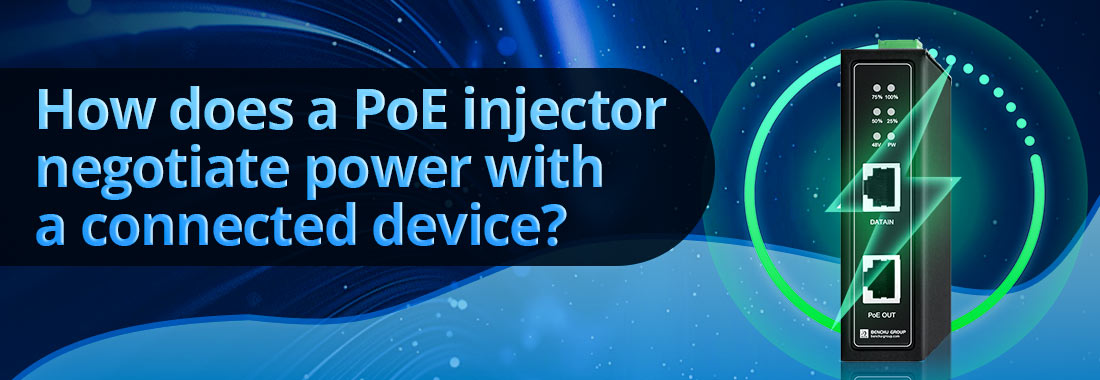
Un injecteur d'alimentation sur Ethernet (POE) est un appareil qui ajoute de l'alimentation à un câble Ethernet, permettant aux commutateurs ou routeurs de réseau non POE non pas Point d'accès ou téléphone VoIP. La négociation de puissance entre un injecteur POE et un dispositif connecté suit un processus standardisé défini par les normes IEEE 802.3af, 802.3at (POE +) et 802.3bt (Poe ++).
Le processus de négociation de l'énergie implique trois phases principales:
1. Détection
2. Classification
3. Livraison et maintenance électriques
1. Phase de détection - Identification d'un appareil PoE
Avant de fournir de l'énergie, le Injecteur de Poe Vérifie si le périphérique connecté est compatible POE.
--- L'injecteur envoie une basse tension (2V à 10V DC) sur le câble Ethernet.
--- Le dispositif connecté (si POE-compatible) contient une résistance de signature de 25 kΩ entre des paires de fils spécifiques.
--- Si l'injecteur détecte cette résistance, il reconnaît l'appareil comme un dispositif (PD) alimenté par POE valide et passe à l'étape suivante.
--- Si aucune résistance valide n'est trouvée, l'injecteur ne fournit pas de puissance, évitant les dommages aux appareils non POE.
2. Phase de classification - Déterminer les exigences de puissance
Une fois que l'injecteur détecte un dispositif compatible POE, il détermine la puissance dont l'appareil a besoin en suivant le processus de classification IEEE POE.
L'injecteur applique une tension de test de 15 V à 20V et mesure le courant de l'appareil.
Sur la base du courant dessiné, l'appareil est affecté à l'une des classes de puissance PoE:
| Norme Poe | Classe | Sortie de sortie (injecteur) | Alimentation disponible (appareil) | Type d'appareil |
| 802.3af (Poe) | 0 | 15.4W | 0,44W à 12,95W | Appareils PoE de base |
| 802.3af (Poe) | 1 | 4W | 0,44W à 3,84W | Capteurs à faible puissance |
| 802.3af (Poe) | 2 | 7W | 3,84W à 6,49W | Téléphones IP |
| 802.3at (Poe +) | 3 | 15.4W | 6.49W à 12,95W | Caméras de sécurité |
| 802.3at (Poe +) | 4 | 30W | 12.95W à 25,5W | Points d'accès sans fil |
| 802.3bt (Poe ++) | 5 | 45W | 25,5W à 40W | Lumières LED haute puissance |
| 802.3bt (Poe ++) | 6 | 60W | 40W à 51W | Caméras PTZ |
| 802.3bt (Poe ++) | 7 | 75W | 51W à 62W | Systèmes de vidéoconférence |
| 802.3bt (Poe ++) | 8 | 100W | 62W à 71W | Moniteurs de grande puissance |
Si le périphérique alimenté ne se classe pas, l'injecteur par défaut est par défaut de la classe 0 (15.4W max).
3. Phase de livraison et de maintenance de puissance - Gestion continue de l'alimentation
Après avoir déterminé les besoins en puissance, l'injecteur PoE commence à livrer la tension requise (généralement 48 V CC) à l'appareil alimenté.
--- L'appareil dessine uniquement la puissance dont il a besoin dans sa classification.
--- L'injecteur surveille la consommation d'énergie en continu.
--- Si l'appareil déconnecte ou dépasse son budget de puissance, l'injecteur arrête la puissance pour éviter les dommages.
De plus, IEEE 802.3bt (Poe ++) introduit AutoClass et LLDP (Protocole de découverte de couche de liaison) pour une négociation de puissance plus précise, permettant des ajustements de puissance dynamiques basés sur les besoins en temps réel.
Conclusion
Un injecteur PoE suit un processus de négociation structuré pour détecter, classer et fournir une puissance à un appareil connecté en toute sécurité et efficacement. En suivant les normes IEEE POE, l'injecteur garantit que les dispositifs non POE sont protégés, que les niveaux de puissance appropriés sont livrés et que l'efficacité énergétique est maintenue. Cela fait de la technologie POE une solution fiable et évolutive pour alimenter les appareils en réseau dans diverses applications.